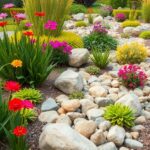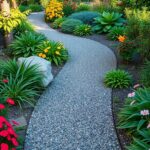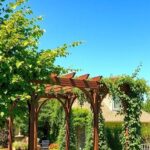Terraced landscaping is a fantastic way to create beautiful, functional outdoor spaces on slopes or uneven terrain. This technique involves crafting a series of flat areas or “terraces” that can be filled with plants, flowers, or hardscaping features like patios. Whether you’re looking to enhance your garden’s beauty or improve drainage and soil retention, terracing offers a stylish solution that can transform your landscape into something truly special.
Water Drainage Solutions in Terraced Landscaping
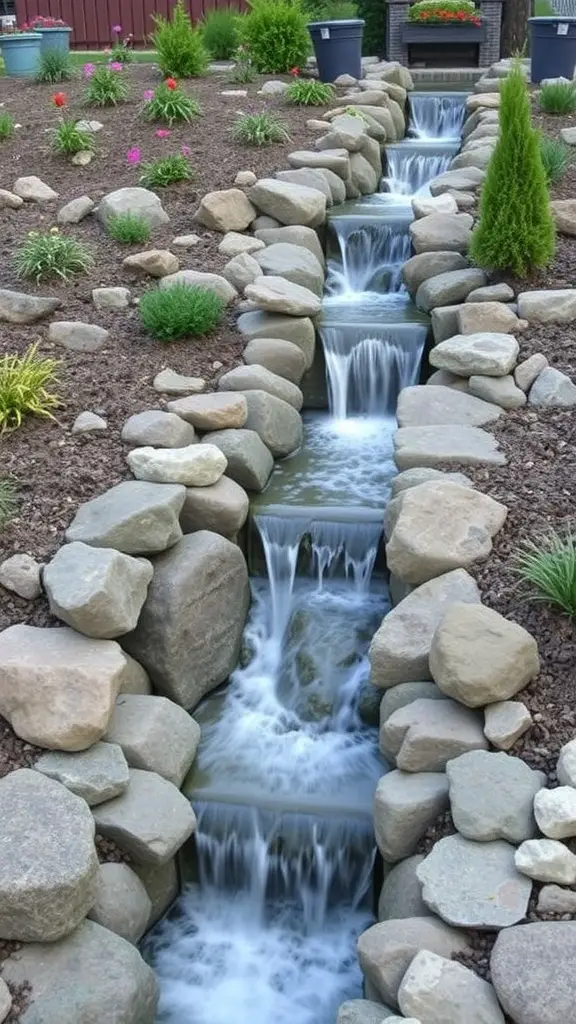
Terraced landscaping is a great way to manage slopes and create beautiful outdoor spaces. One key aspect of this design is effective water drainage. Proper drainage helps prevent water from pooling and causing erosion.
The image illustrates a simple drainage system. It shows how water flows through different layers of soil, ensuring it moves away from the plants and structures. The arrows indicate the direction of water flow, which is crucial for maintaining healthy plants.
In terraced gardens, having a reliable drainage system is essential. It helps keep the soil stable and supports plant growth. Without it, heavy rains can wash away soil and damage the landscape.
Using techniques like French drains or swales can enhance drainage. These methods redirect water to designated areas, minimizing the risk of flooding. By incorporating these solutions, you can enjoy a thriving garden without worrying about water damage.
Incorporating Pathways in Terrace Designs
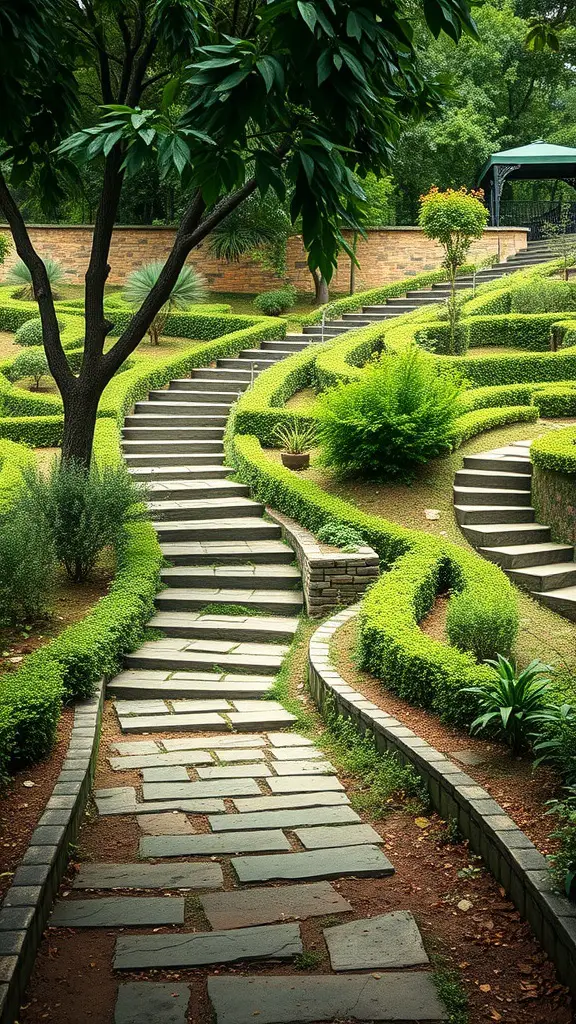
Pathways play a key role in terraced landscaping. They guide visitors through the space, making it easy to explore different levels and areas. The image shows a beautifully designed path winding through lush greenery, creating a sense of flow.
Using materials like stone or gravel can enhance the natural look of your terrace. The path in the picture is made of stone slabs, which blend well with the surrounding plants. This choice not only adds beauty but also provides a sturdy surface for walking.
Curved pathways, like the ones shown, can soften the overall design. They invite curiosity and encourage people to wander and discover hidden spots. You might even consider adding seating areas along the way, where one can pause and enjoy the view.
Lighting is another important aspect. Subtle lighting along the pathways can create a magical atmosphere at night. It highlights the beauty of the plants and makes the space inviting even after sunset.
Lighting Ideas for Terraced Landscapes
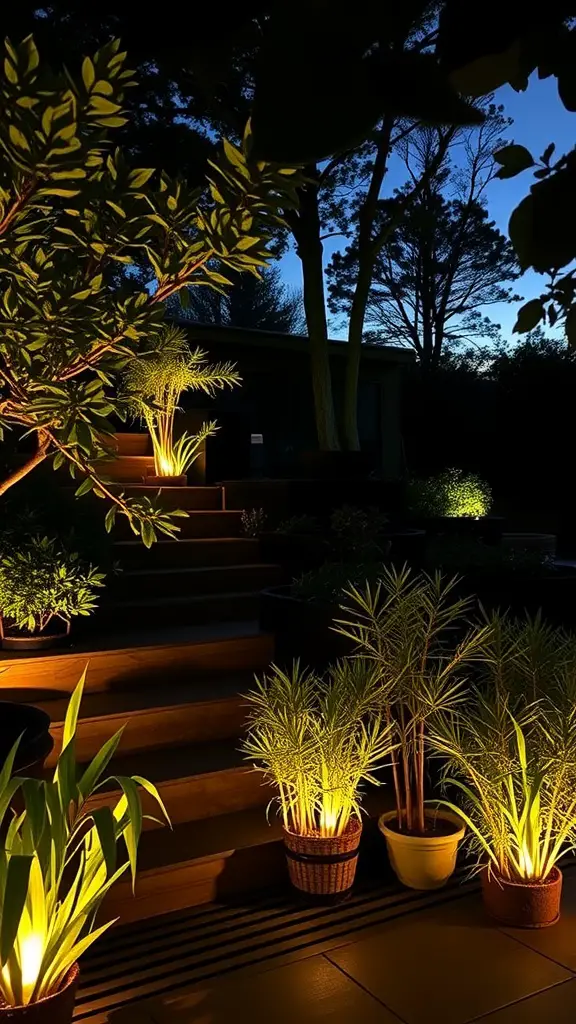
When it comes to terraced landscaping, lighting plays a key role in creating an inviting atmosphere. The image shows a beautifully lit terrace at night, showcasing how effective lighting can enhance the beauty of your outdoor space.
The warm glow from the lights highlights the steps and surrounding plants, making the area feel cozy and welcoming. Using uplights on the plants adds depth and draws attention to their lush greenery. This technique not only illuminates the space but also creates a stunning visual effect.
Consider using different types of lights, such as path lights along the steps or spotlights to accentuate specific plants. This variety can add interest and make your terrace feel more dynamic. The combination of soft lighting and natural elements creates a peaceful retreat, perfect for evening gatherings or quiet moments.
Incorporating lighting into your terraced landscape can transform it into a magical space after sunset. Whether you choose solar lights, LED fixtures, or string lights, the right lighting can make all the difference in how you enjoy your outdoor area.
Creating Visual Interest with Levels
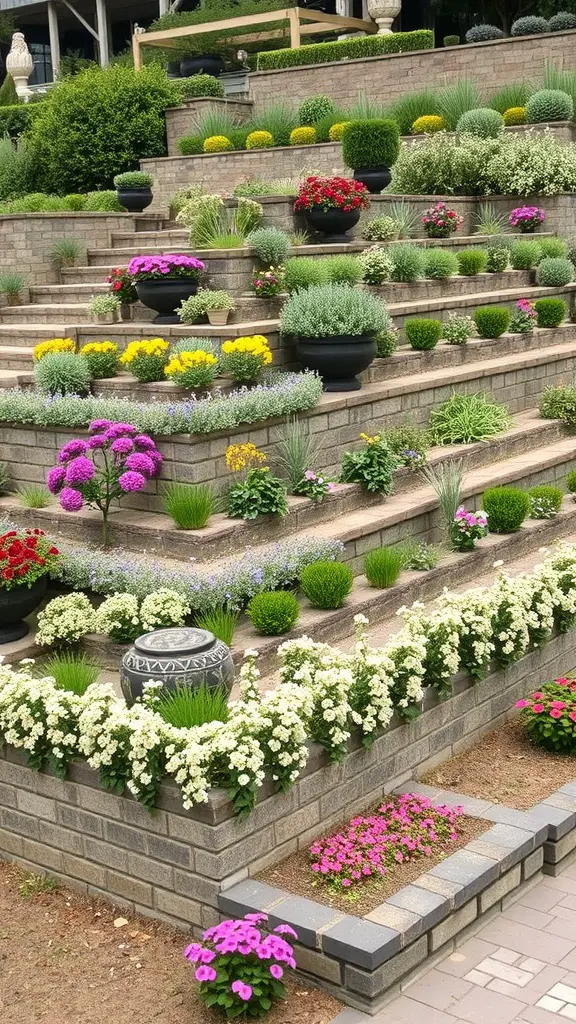
Terraced landscaping is a fantastic way to add depth and character to your outdoor space. The image showcases a beautifully designed terraced garden, where each level is filled with vibrant plants and flowers. This arrangement not only looks stunning but also maximizes the use of space.
The steps create a natural flow, guiding the eye from one level to the next. Each tier features a mix of colorful blooms and lush greenery, making it a feast for the eyes. The use of planters adds a touch of elegance, allowing for a variety of plant choices.
Incorporating different heights in your garden can break the monotony of flat landscapes. It invites exploration and creates cozy nooks for relaxation. Whether you have a small yard or a larger area, terraced landscaping can transform it into a vibrant retreat.
Designing Your First Terrace
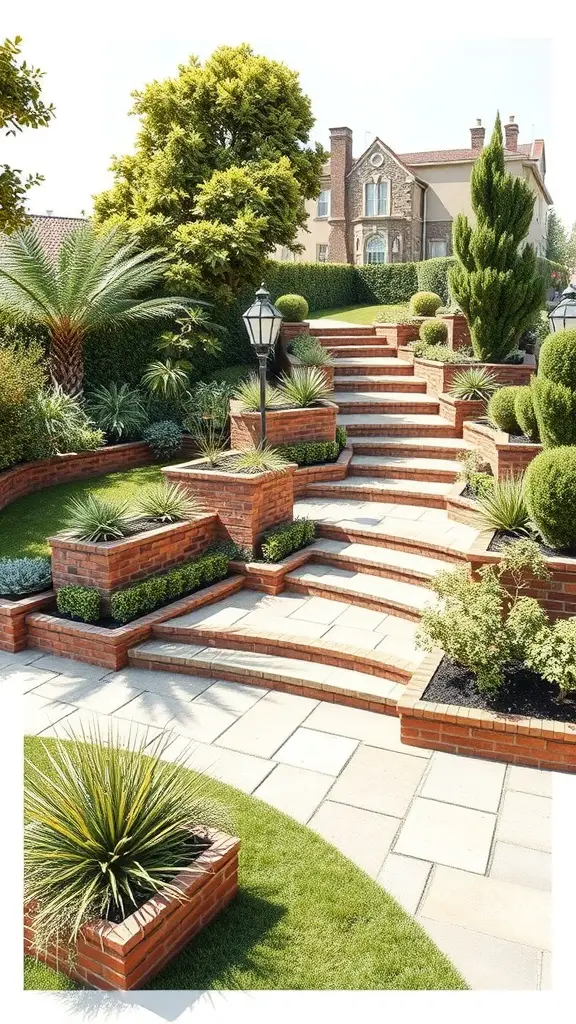
Creating a terrace can be a fun project that adds beauty and functionality to your outdoor space. The image shows a well-designed terraced landscape with steps leading up to a charming home. Notice how the steps are lined with lush greenery and decorative plants, making the area inviting.
The use of brick for the terracing not only provides structure but also adds a warm touch. The combination of different plants, from palms to neatly trimmed bushes, creates a vibrant look. This variety can make your terrace feel alive and full of character.
When designing your first terrace, think about how you want to use the space. Do you want a cozy seating area? Or perhaps a small garden? Planning these elements will help you create a space that fits your lifestyle.
Consider the layout as well. The steps in the image show a gradual rise, which is easy to navigate. You might want to incorporate similar features to ensure your terrace is both functional and beautiful.
Plant Selection for Terraced Gardens
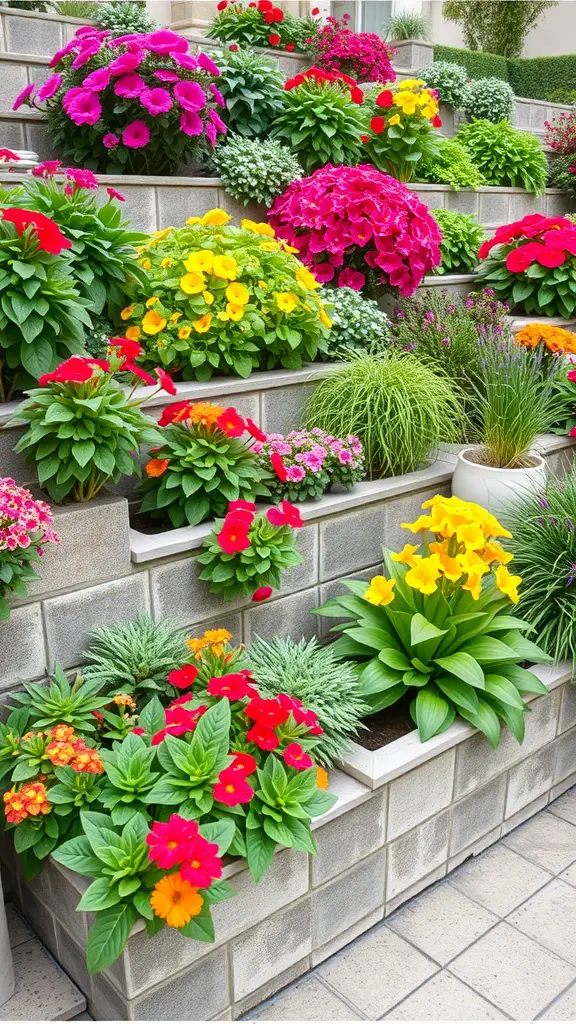
Creating a terraced garden is a fun way to add beauty to your outdoor space. The image shows a vibrant display of flowers cascading down steps, showcasing how colorful plants can transform a simple structure into a lively garden.
When choosing plants for terraced gardens, think about the sunlight and moisture levels in each area. Some plants thrive in full sun, while others prefer partial shade. For example, petunias and marigolds love the sun, while ferns can handle shadier spots.
Consider the height and spread of each plant. Taller plants, like sunflowers or delphiniums, can be placed at the back or top of the terrace, while shorter ones, like pansies or creeping thyme, can fill in the front. This layering creates depth and interest.
Mixing different types of plants can also add texture. Combine flowering plants with greenery for a balanced look. Herbs like basil or mint can be a great addition, providing both beauty and functionality.
Lastly, don’t forget about seasonal changes. Choose a mix of perennials and annuals to keep your garden looking fresh throughout the year. With the right selection, your terraced garden can be a stunning focal point in your yard.
Understanding Terraced Landscaping Benefits
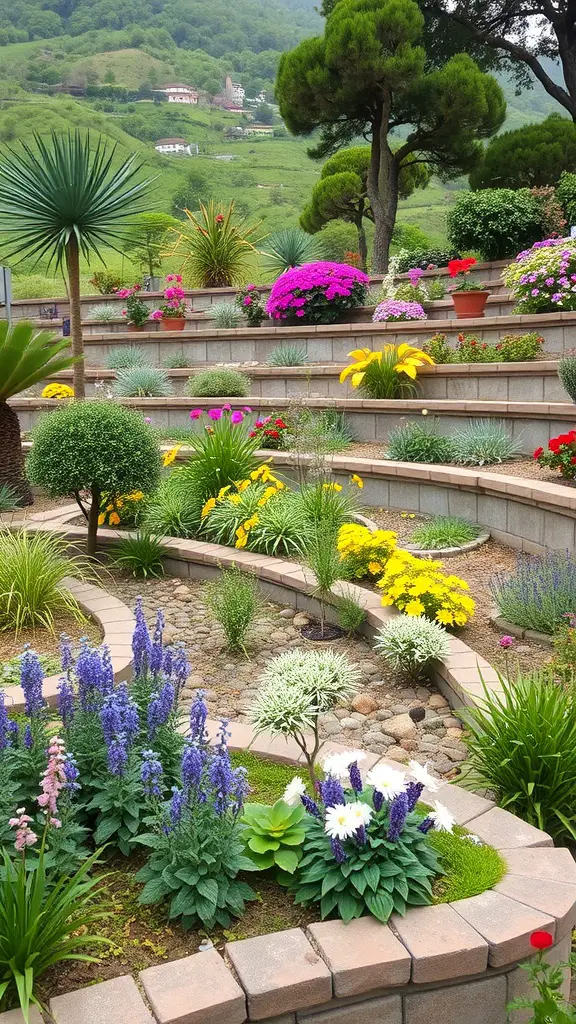
Terraced landscaping is a fantastic way to make the most of sloped areas in your yard. The image shows a beautifully designed terraced garden, showcasing various plants and flowers arranged in steps. This design not only looks appealing but also serves practical purposes.
One major benefit of terraced landscaping is erosion control. By creating flat areas on slopes, you can reduce soil runoff during heavy rains. This helps keep your plants healthy and your garden intact.
Another advantage is the creation of microclimates. Different levels can provide varying amounts of sunlight and moisture, allowing you to grow a wider variety of plants. In the image, you can see colorful flowers thriving in this setup, each benefiting from its unique spot.
Terraced gardens can also enhance accessibility. The steps make it easier to navigate the space, allowing you to tend to your plants without straining yourself. Plus, they add visual interest to your landscape, making your outdoor space more inviting.
Overall, terraced landscaping is a smart choice for anyone looking to beautify their garden while addressing practical concerns. The vibrant colors and structured layout in the image perfectly illustrate the charm and functionality of this gardening style.
Choosing the Right Materials for Terraces
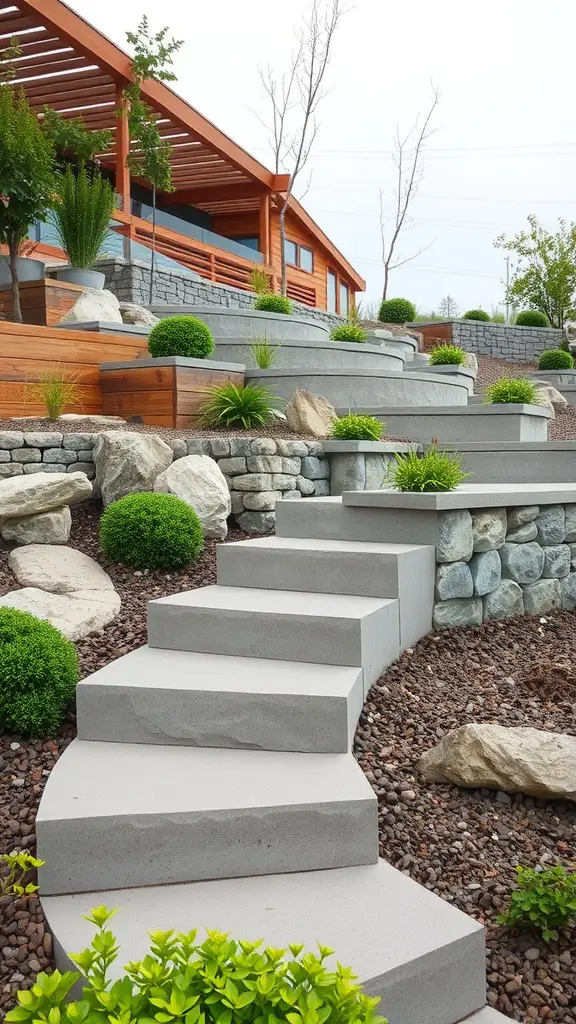
When it comes to terraced landscaping, selecting the right materials is key. The image showcases a beautiful terrace design featuring smooth stone steps, natural stone walls, and lush greenery. Each element plays a role in creating a harmonious outdoor space.
First, consider the steps. The use of concrete or stone for the steps not only adds durability but also enhances the aesthetic appeal. Smooth, wide steps are inviting and safe, making them a practical choice for any terrace.
The retaining walls, made of natural stone, provide stability while adding texture. They can blend seamlessly with the surrounding landscape, creating a cohesive look. Using local materials can also help the terrace feel more connected to its environment.
Don’t forget about the plants! Low-maintenance greenery, like boxwoods and ornamental grasses, can soften the hard surfaces. They add color and life, making the terrace feel more inviting. Choosing plants that thrive in your climate will ensure your terrace remains vibrant year-round.
Lastly, think about the ground cover. Gravel or decorative stones can be practical choices, offering good drainage and a clean look. They can also reduce weed growth, making maintenance easier.
Terraced Landscaping for Erosion Control
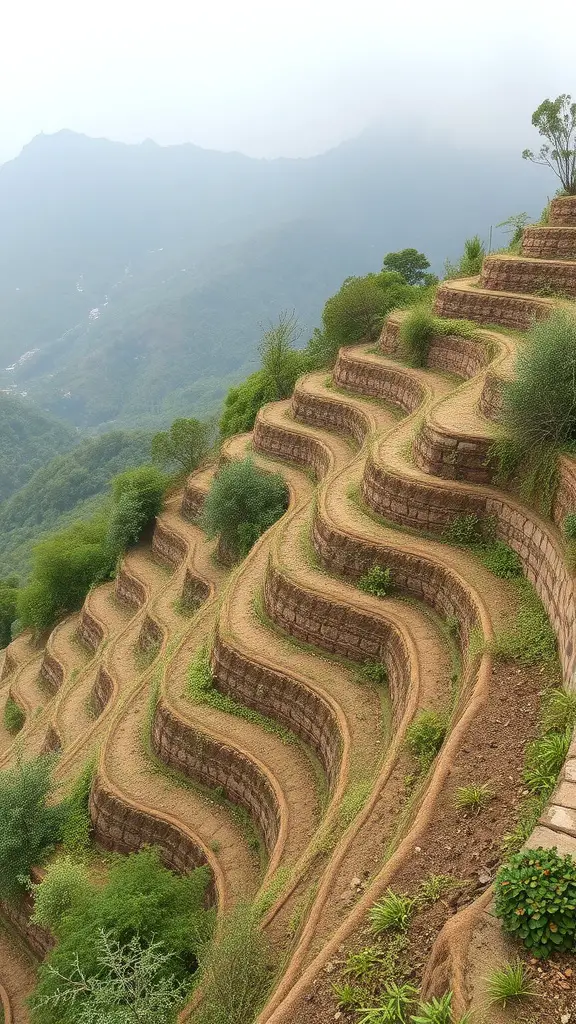
Terraced landscaping is a smart way to tackle erosion, especially in hilly areas. The image shows a stunning example of terraced land, where the earth is shaped into steps. This design helps to slow down water runoff, which can wash away soil. Each level captures rainwater, allowing it to soak into the ground rather than flowing away.
These terraces not only prevent erosion but also create beautiful spaces for planting. The gentle curves and layers make the landscape visually appealing. Plants can thrive in these terraces, adding greenery and stability to the soil. This method is effective for both aesthetics and functionality.
Using terraced landscaping can also support local wildlife. The variety of plants can attract birds and beneficial insects, creating a balanced ecosystem. Overall, terraced landscaping is an excellent choice for anyone looking to enhance their property while protecting the environment.
Terraced Landscaping for Small Spaces
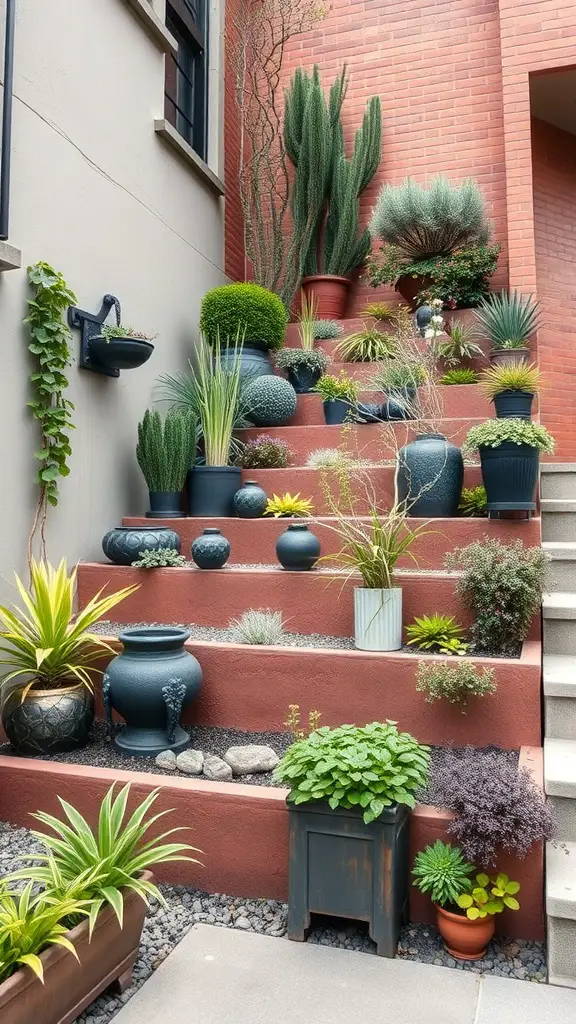
Terraced landscaping is a fantastic way to make the most of small outdoor areas. The image shows a beautifully designed terraced garden that showcases how you can create depth and interest even in limited space.
The steps are lined with a variety of plants, from tall cacti to lush greenery, all arranged in stylish pots. This not only adds color but also texture, making the space feel alive and inviting.
Using different heights in your plant selection can draw the eye upward, creating an illusion of more space. The earthy tones of the terracing complement the vibrant plants, making everything pop.
Incorporating stones and gravel around the plants helps with drainage and adds a clean look. This design is perfect for anyone looking to bring a bit of nature into their urban setting.
Combining Hardscaping with Softscaping
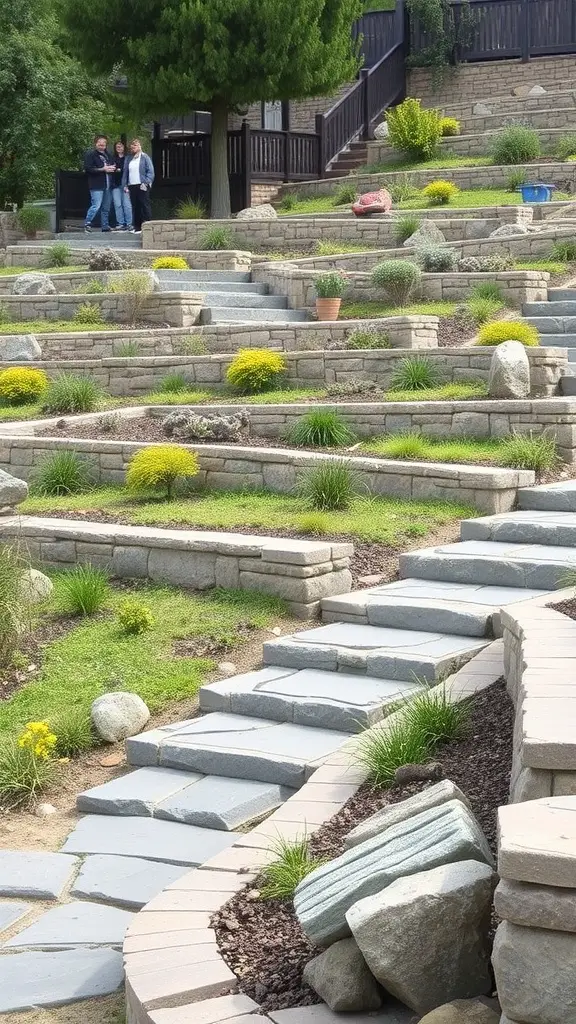
In this terraced landscape, the blend of hardscaping and softscaping creates a stunning visual appeal. The stone steps lead the eye through the different levels, inviting exploration. Each terrace is framed by lush greenery and vibrant flowers, adding life to the structured elements.
The use of stone and concrete for the pathways and walls provides a solid foundation. This hardscaping contrasts beautifully with the softscaping, which includes various plants and shrubs. The combination not only enhances the beauty but also creates functional spaces for relaxation and enjoyment.
Notice how the plants are strategically placed to soften the edges of the hard surfaces. This thoughtful arrangement makes the space feel welcoming and harmonious. It’s a perfect example of how hardscaping can work hand-in-hand with nature to create an inviting outdoor area.
Incorporating Water Features in Terraces
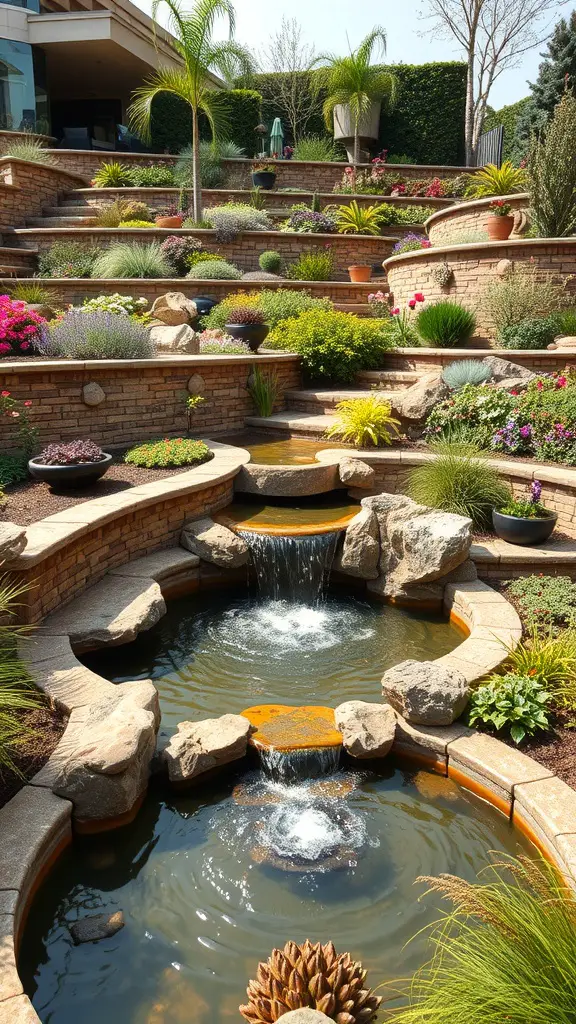
Water features can bring life to terraced landscaping. They add a soothing sound and a beautiful visual element. In the image, you can see a lovely waterfall cascading down a series of stone steps. This design not only looks great but also creates a peaceful atmosphere.
The plants surrounding the water enhance the overall appeal. Colorful flowers and lush greenery complement the flowing water. This combination draws the eye and invites people to explore the space. It’s a perfect spot for relaxation or a casual stroll.
When planning your terraces, think about how water features can fit in. A small pond or a fountain can make a big difference. They can serve as a focal point, making your landscape feel more dynamic and inviting. Plus, the sound of water can create a calming environment, perfect for unwinding after a busy day.
Terraced Vegetable Gardens: A Sustainable Approach
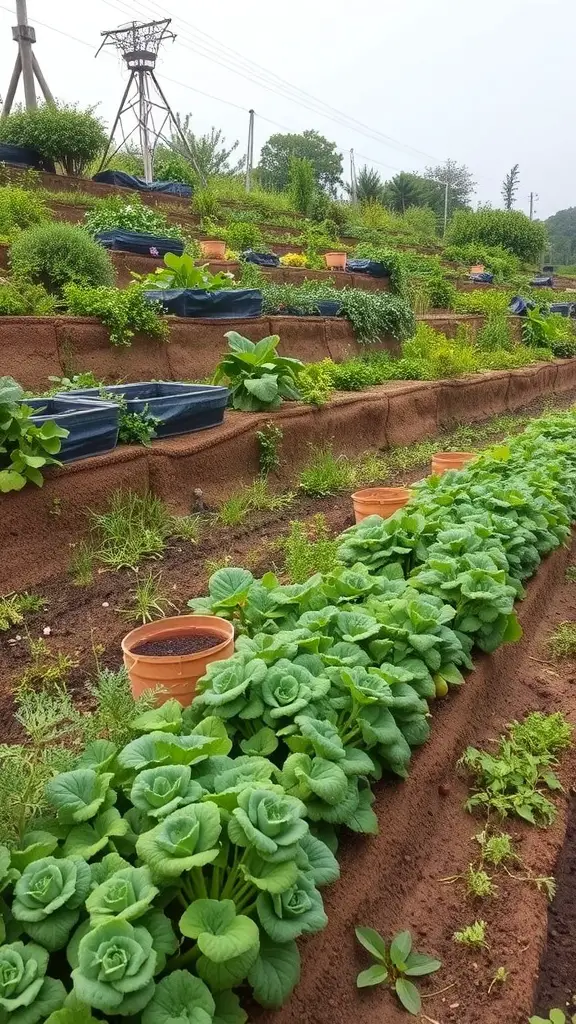
Terraced vegetable gardens are a fantastic way to grow your own food while making the most of your space. The image shows a beautifully arranged terraced garden, with lush green plants thriving in neat rows. Each level of the terrace is filled with various vegetables and herbs, showcasing the potential of this gardening method.
Using a terraced layout helps manage water flow and soil erosion, making it an eco-friendly choice. The raised beds allow for better drainage and can be easier on your back when tending to your plants. In the image, you can see pots placed strategically, adding a pop of color and variety to the garden.
This approach not only maximizes space but also creates a visually appealing landscape. The different heights create a unique aesthetic that can transform any backyard into a productive oasis. Plus, growing your own vegetables means you can enjoy fresh produce right from your garden!
Seasonal Planting Strategies for Terraces
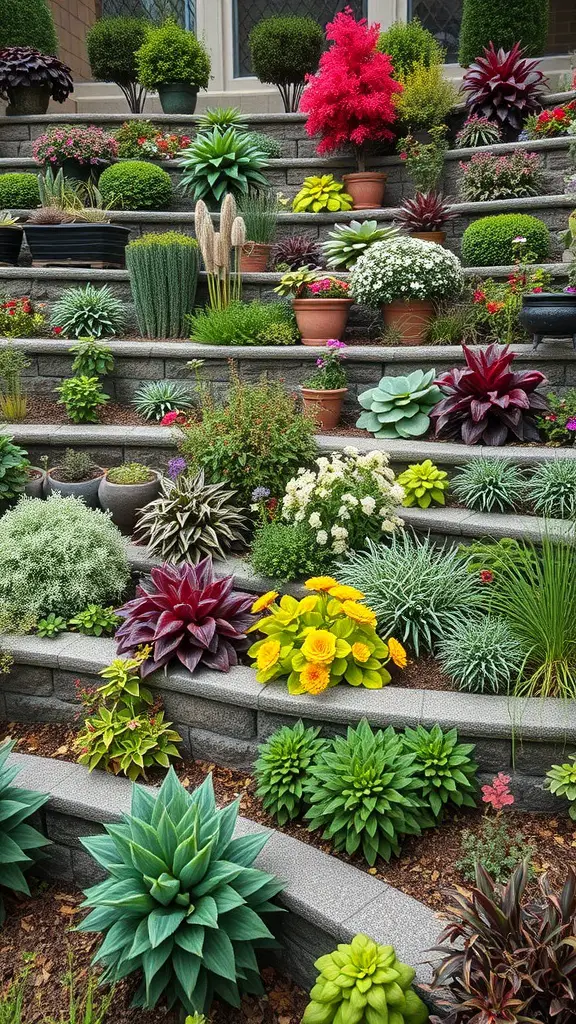
Terraced landscaping offers a unique way to showcase plants at different heights, creating visual interest and maximizing space. The image shows a vibrant array of plants arranged in a tiered fashion. Each level is filled with various colors and textures, making it a feast for the eyes.
When planning seasonal planting for terraces, consider the climate and the specific needs of each plant. For spring, opt for bright blooms like pansies and tulips to bring life back to your garden. Summer is perfect for colorful annuals such as marigolds and petunias that thrive in the sun.
As fall approaches, think about planting chrysanthemums and ornamental grasses. These plants not only add color but also provide texture as the season changes. Winter can be tricky, but evergreens and hardy perennials can keep your terrace looking lively even in the cold.
Mixing plants in pots and directly in the soil can add depth to your design. Use taller plants at the back or top of the terrace and shorter ones in front. This layering effect allows each plant to shine while creating a cohesive look.
Maintenance Tips for Terraced Landscapes
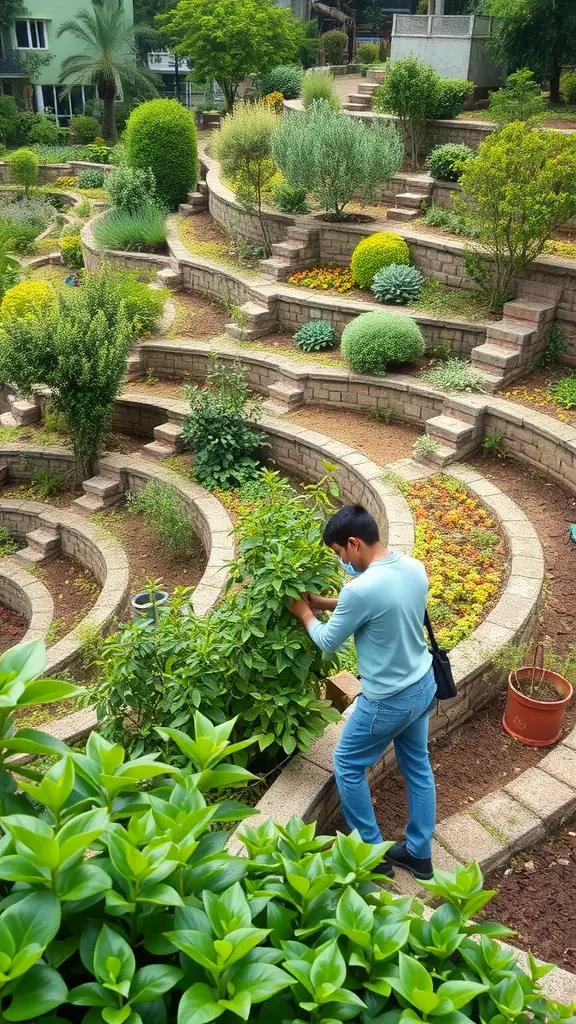
Terraced landscaping offers a stunning way to utilize sloped areas, creating beautiful layers of plants and pathways. The image shows a person tending to a terraced garden, surrounded by various plants in pots and a winding stone path. This setup not only looks great but also requires some care to keep it thriving.
Regular watering is key. Make sure each level gets enough moisture, especially during dry spells. Using drip irrigation can help reach every plant without wasting water.
Weeding is another important task. Weeds can quickly take over, so check each terrace regularly. Pull them out by hand or use mulch to suppress their growth.
Pruning your plants keeps them healthy and encourages growth. Trim back any overgrown branches and dead leaves to promote air circulation and prevent disease.
Fertilizing is essential too. Use organic fertilizers to give your plants the nutrients they need. This can be done in spring and mid-summer for the best results.
Finally, don’t forget about the pathways. Keeping them clear of debris not only looks nice but also prevents accidents. Regularly check for loose stones or uneven surfaces.

